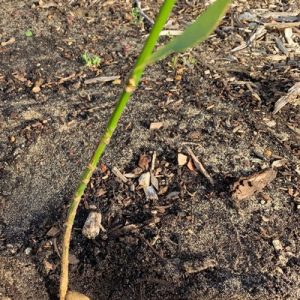Garcinia livingstonei
Imbe, African mangosteen
Origin
Native regions for most Garcinia are Malesia but Imbe comes from tropical Africa as an understory tree. It is now pantropical, either as wild or backyard trees as it is not grown commercially; fruit is either self-consumed or sold in local markets. Imbe is the most important of about 15 African Garcinia species with edible fruits.
Climate
It prefers tropical rain forests, sea level to 800m, and the hot sub-tropics. In cooler subtropical climates it grows too slowly to be productive. Best results are obtained if there are no frosts, although mature trees may survive brief exposures; optimal mean annual temperature is 20-23°C. It can tolerate dry seasons of several months but yield will be decreased; rainfall in native areas is 400-1800mm pa. There is also some salt tolerance.
Plant Description
Imbe is a slow growing shrub or small tree (5-10m high) with a dense spreading or conical crown on a short, often twisted scaly grey-brown trunk with vertical fissures, and a bulbous root system. It is evergreen in the tropics, and all parts produce a yellow-red latex when bruised. Leathery dark green simple glabrous lanceolate, oblong-elliptical or oblanceolate leaves (3-10 X 2-5cm) on 2-7mm petioles are borne in opposite pairs or whorls of 3-4, have a prominent primary nerve and an intra-marginal vein that merges with the margin.
Relatives
Garcinia is a large genus with slightly more than 400 species in the Clusiaceae family. Many species have edible fruits and the best known of these is mangosteen (Garcinia mangostana), often called the Queen of Fruits in sth East Asia. Others are madrono, achachairu, bacuri, bakupari, gamboge, kokum butter tree, cherapu and lemon drop mangosteen. Genetic studies show that Garcinia gummi-gutta (Malabar tamarind) is a close relative of Imbe.
Soils
Trees are quite adaptable and thrive in adverse sites, including dry, damp, sandy, or rocky locations. Soils vary from deep sands to heavy alluvial soils along riverbanks.
Propagation
Mainly by seeds that are recalcitrant but germinate readily (hypogeal, cryptocotylar) while fresh and kept warm and moist. They can also be vegetatively propagated by air layering, budding or grafting. Imbe has been tried as a grafting root stock for mangosteen as it could extend culture beyond the tropics. Unusual seedling development in Imbe is classified as the Garcinia type by seed scientists, where initially the shoot emerges at one seed pole and a primary root at the other. This is followed by a secondary root at the shoot pole after which the primary root slowly degenerates. Cotyledons are rudimentary and most of the seed is filled with the hypocotyl that serves as a nutrient reservoir.
Cultivars
Imbe has been judged one of the top 10 most promising wild fruits of central Africa, deserving research and development. But very little has been done so far and reliance is placed solely on selected wild plants. There are no named cultivars but these selections would be a good starting point for eg reducing the long juvenility period, and increasing fruit size, regularity of bearing and improved flesh to seed ratio.
Flowering and Pollination
Axillary or ramiflorous inflorescences occur as fascicles on older wood with 2-7 unisexual fragrant sessile or pedicellate greenish-white to yellow flowers. Male flowers (8-10mm dia, pedicels 6-8mm long) have 4, 2-whorled sepals, 5 free petals (4-5 X 3-4mm), a globose yellow disc and about 30 free stamens on short filaments with no pistillode. In female flowers (7mm dia, pedicels 15-20mm long), there are 4 free sepals, 5 free petals (8 X 6mm), a yellow disc with 26 X 2mm long staminodes, and a superior globose ovary that is 2-locular with one ovule per locule. The bi-lobed stigma is sessile or on a short style. Asexual reproduction by seeds is common in Garcinia, and Imbe behaves as a facultative apomict (mangosteen is obligate). The relative degree of outcrossing is mainly dependent on environmental conditions, proximity of other plants and pollination vectors. Many insects are attracted to pollen and nectar in the flowers but bees are the main pollinators.
Cultivation
Trees are resilient when mature and may survive considerable neglect, but respond very well to sound cultural practices. Detailed optimal horticultural management practices have not been established to date.
Wind Tolerance
Good, given it’s a small tree often with multiple trunks.
Pruning
Without precise guidance, standard vase-shaped pruning with controlled height would seem prudent. Although normally trees, they can be planted close together and trained as a hedge.
The Fruit
The small, green turning orange-red oblong-ellipsoid fleshy berries (10-30 X 10-30mm) are juicy and have variably sweet to-acid arils, some say apricot-like. The skin is smooth, glossy, and leathery tough but separates easily from the flesh, with some of the succulent pulp remaining attached to the 1-2 plano-ovoid seeds (8-20mm long) which are not eaten. Seeds are quite large in proportion to the fruit, meaning the edible pulp is correspondingly thin. Sticky yellow latex is exuded in unripe fruit. Some trees produce fruit with thicker skins and these present a valuable breeding opportunity to improve transportability and storage, vastly changing commercial prospects.
Fruit Production and Harvesting
Once through the long seedling juvenility period (10-15 years), the species produces abundantly.
Fruit Uses
The pulp is usually eaten fresh but can also be used to produce drinks, fermented beverages, preserves and jams. If seeds are removed, the flesh can be dried and stored like a pitted prune.
Pests and Diseases
Little experience in WA. Likely minimal but fruit fly problems have been reported in some countries.
Comments
A big disadvantage of imbe is the slow growth. Positive features for Perth growers are good yield, and mature tree resilience to adverse soil and drought conditions. It could be planted solely for its attractiveness and fragrant flowers.
